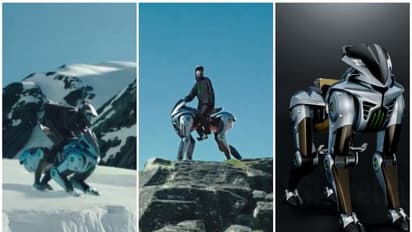Jaw-dropping! Kawasaki's hydrogen-powered, ride-on robo-HORSE takes internet by storm (WATCH)

Synopsis
Kawasaki Heavy Industries, the Japanese powerhouse renowned for its high-performance motorcycles, has unveiled a hydrogen-powered, ride-on robotic horse named CORLEO.
Move over, robot dogs- there's a new four-legged marvel in town, and it’s straight out of a sci-fi fantasy. Kawasaki Heavy Industries, the Japanese powerhouse renowned for its high-performance motorcycles, has unveiled a hydrogen-powered, ride-on robotic horse named CORLEO.
This mechanical beast made its dramatic debut at the Osaka Kansai Expo on April 4, as the crown jewel of Kawasaki’s bold “Impulse to Move” initiative. With the agility of a mountain goat and the muscle of a warhorse, this two-seater quadruped is engineered to conquer terrains where wheels dare not tread.
Rather than traditional tires, CORLEO is equipped with four intelligent robotic limbs, each ending in a cloven-hoof-inspired structure designed to gracefully traverse grasslands, rocky outcrops, and rubble-strewn paths. “These hooves can adapt to various terrains, including grasslands, rocky areas, and rubble fields,” the company states.
Unlike most robotic creatures, CORLEO mimics the forward-hinged back legs of real animals such as horses or wolves — a deliberate deviation from the rear-facing design of Boston Dynamics' famed robot dog, Spot. According to Kawasaki, “each of these rear legs can swing up and down independently from the front leg unit” to better cushion high-impact movements and offer a smooth ride over uneven ground.
Steering this robotic stallion doesn’t require reins or handlebars in the traditional sense. Instead, riders shift their weight while the vehicle’s AI-driven vision system selects the optimal route. And to prevent any high-speed tumbles, CORLEO continuously tracks its rider's posture to maintain “a reassuring sense of unity.”
With futuristic stirrups and sensors embedded in the handlebars, riders maintain balance and control through subtle bodily adjustments — an eerily organic riding experience.
Ride-on robo-HORSE can gallop over almost any terrain
Beneath the sleek, beastly frame lies its beating heart: a 150cc hydrogen generator, pulling fuel from onboard tanks and transforming it into pure energy to power the leg motors. The only trace it leaves behind? Clean water. “Unlike a real horse,” Kawasaki boasts, “this means the only waste CORLEO will leave on the roads will be clean water produced by burning hydrogen.”
For night riders, CORLEO’s tech suite doesn’t disappoint. Its instrument panel delivers real-time data such as hydrogen levels, slope angles, and center of gravity. And in the dark, it projects guiding markers onto the road ahead, lighting the path like a luminous trail of breadcrumbs.
In a jaw-dropping promotional video, the robo-horse is seen bounding across rugged landscapes — from grassy plains to craggy peaks — with a human rider clinging on like a robotic cowboy.
Kawasaki did present a physical prototype at the Expo — but the current version is more show pony than stallion.
Also read: US vs China: Who is winning the humanoid robot race and how? Explained (WATCH)
Check the Breaking News Today and Latest News from across India and around the world. Stay updated with the latest World News and global developments from politics to economy and current affairs. Get in-depth coverage of China News, Europe News, Pakistan News, and South Asia News, along with top headlines from the UK and US. Follow expert analysis, international trends, and breaking updates from around the globe. Download the Asianet News Official App from the Android Play Store and iPhone App Store for accurate and timely news updates anytime, anywhere.